![]()
![]()
![]()
![]()
![]()
![]()
![]()
![]()
![]()
![]()
![]()
![]()
BOOST LEAK LOCATOR GUIDE
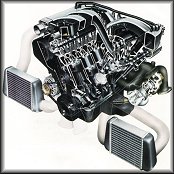
IF YOU HAVE INSIGHTS, CORRECTIONS, EXPLANATIONS, or REPAIR
WRITE-UPS, PLEASE email me SO I CAN MAKE UPDATES!
If you own a Twin Turbo, you've probably seen a lot of talk about BOOST LEAK. And if you've ever posted a question about "lack of power" or "low boost", you've certainly had a response that reads "Do you have a boost leak?"
| This article assumes that you know how to Phentermine 37.5 mg oval tablets, and that you have the appropriate tools
(compressor and Cheapest pharmacy to fill adderall without insurance) to do so. It also assumes that you have an
aftermarket boost gauge so you aren't guessing what your boost
really is. A good boost gauge IS A MUST! I also suggest at least a
fuel pressure gauge.
Gauges provide you with certainties (eliminating variables) and generate accurate data for evaluation. Be very familiar with the terms and concepts provided in Ash's "Lorazepam 1 mg to buy" (AutoFaq on TT.net). You need to know if your car is UP TO PAR so you aren't wasting time and money trying to get more power out of a car that won't ever provide it. Plus you could damage your car modifying what isn't ready to be modified. |
Despite many good articles on how to perform a boost leak check, I have yet to see a write-up that specifically discusses the "common boost leaks", where to find them, and how to fix them. Another tt.net member posted back in '03 asking for info like this, but there was not a single response:
"Boost, Leaks and the rest..."
Hopefully this write-up will fill a void. The info here would've helped me a lot while looking for answers. There is also a Q&A section below (not complete) that might help explain some misunderstood boost/vacuum leak concepts.
Though a boost leak test will effectively point out leaks, it's nice to have a head start by knowing where leaks might show up. Since the goal is ZERO BOOST LEAKS, I have also developed a complete checklist of components that can be under vacuum/boost along with vacuum hose diagrams (Adderall generic how supplied) so you can check each of them (if you want to!)
WHEN SHOULD YOU PERFORM A BOOST LEAK TEST?
As noted in "The 6 P's" (see link above), this should be part of continual maintenance. Often you will not be able to perceive boost leaks unless you test for them. If you continually perform boost leak tests, you will be ready to tackle them when it becomes convenient. One example - if your EGR valve is leaking, you are not likely going to pull the engine, tranny, or plenum/lower intake to replace it. However, if your clutch goes out and you know you need to do the EGR, you'll know it! Makes life a lot easier to replace these kind of things when bigger work is being done. At the very least, if you are going to do major work, do a boost leak check beforehand. So, keep doing boost leak checks and you're life will be made easier and your car will always run nicely.
MY BOOST LEAK HISTORY
Once a few months ago I performed a boost leak test and found only one leak. It was at the back of the engine. I never pinpointed it and didn't fix it. Even though I had the leak, my gauge (Autometer) indicated a solid 15 psi of boost (w/fuel pressure holding 60).
Then one day after completing some non-related work on my Z, I took it out for a quick drive and found that I had lost boost entirely! There are a few things that cause zero boost:
- Very bad boost leak (detect and repair)
- Blown or seized turbo (repair or replace)
- Stuck wastegates or recirculation valves (rev trick, adjustment, repair or replace)
Knowing very little beforehand about how the whole intake system is designed, I started on a fairly involved investigation. Ultimately what I found was three boost leaks: 1) Turbo outlet driver side hose 2) Turbo outlet passenger side hose 3) IAA (Idle Air Adjust unit). The outlet hoses were significant enough to drop boost to ZILCH, NADA, ZERO.
I fixed all of these leaks (explained below in detail). As a reward for doing so my car is running better than ever! With the same boost jets (.045) my gauge now indicates 16 PSI solid and turbo response time is much better than before. I have since retested my system and found ANOTHER leak, which is from the EGR. This is a common leak, and very tough to fix. It requires a plenum pull to bypass and a tranny drop or engine pull to remove/replace! And, the buns about it, many need to keep the EGR for emissions!
If you think your can is running perfectly, but you've never done a boost leak check or tightened all your clamps, DO IT NOW! Note that I intend to run 14 PSI...been needing a set of .050 jets or a drill to open up a .045, although I may soon get an EBC instead. I also have race fuel in the car right now (remnant from drag strip), so running 16 isn't too ridiculous. I can't wait to get back on that strip, drop my 60', and get a respectable time slip : )
POSITIVE PRESSURE (BOOST) and NEGATIVE PRESSURE (VACUUM)
A normally aspirated (non-turbo) intake is always under vacuum (negative pressure) except during acceleration when near zero pressure might be reached. A turbo intake is also under vacuum until acceleration -- but on a forced induction engine, the turbo (or alternatively, a supercharger) creates boost putting everything beyond the turbo outlet (including the intake manifold and anything attached to it) under POSITIVE PRESSURE. Only the section of intake between the air filter and turbo outlet remains under vacuum.
If you have a vacuum leak off the manifold under negative (vacuum) pressure, it can turn into a boost leak under boost. When you do a boost leak test, you are artificially boosting the entire intake tract. Any leak detected should be fixed because it will either leak boost or suck in unmetered air.
Vacuum leaks generally cause hesitation or inconsistent component operation (ie, idle valve). They can also cause a LEAN condition as the car will suck in unmetered air, which is any air entering the intake system beyond the Air Flow Meter. A lean condition can, and likely will, manifest itself as detonation!
Boost leaks generally cause poor performance (loss of power) and a RICH condition as metered air is leaving the system while the fuel to be injected has already been calculated. Even if you can hit full boost (with a boost leak) you are losing out -- the turbo has to work overtime (spin faster) to maintain peak boost. This will tend to increase intake temps, too. So a boost leak, which will tend to make you run rich, can actually lead to detonation as well!
LOCATING BOOST LEAKS
Anything in the intake tract from the air filter to the cylinders has the potential for boost/vacuum leak. However, the most common leaks found are associated with loose hose clamps on the large intake pipes. Even if you don't find leaks, you may want to tighten down all clamps as a matter of continued maintenance.
When you do your boost leak test, use the pictures/graphics provided below to determine where the leak may be coming from. If you can hear a leak, but can't pinpoint it, use some soapy water solution and you should be able to detect the leak precisely. If the area is not visible, you can use a length of vacuum hose to pinpoint leaks. Just "stick it in your ear", move the hose around, and when you are close you'll hear it. This is how I found that my EGR was leaking!
A list of possible boost leaks would include:
- Most Common: Large piping (soft and hard pipes) and their associated clamps
- Intercoolers
- Turbo's themselves
- Turbo Intake-Outlet hoses (VERY COMMON)
- ANY device or hose attached to the intake manifold (EGR, IAA/IAVC, AIR REGULATOR, BOOST SENSOR, aftermarket boost gauge, anything else pulling a vacuum line off the manifold, etc). Generic adderall barr vs corepharma for a complete list!
- Manifold itself (along gaskets)
The pictures immediately below show the location of readily visible intake clamps. The legend defines the colored dots. The dots indicate clamp location and the pressure state of the associated piping when intake manifold pressure is positive (under boost). Again, you may as well tighten them all even if you don't hear a boost leak, just to avoid future problems. The white arrows show the direction of air flow. Side note: all the hose clamps on my '91 TT have flat head slots with 8mm heads.


The intercoolers are located at the front corners of the car (one for each turbo). You can see them if you duck down and look through the intercooler scoops on the bumper cover/fascia. There are other clamps and hoses not seen here, such as those down by the turbos and intercoolers.
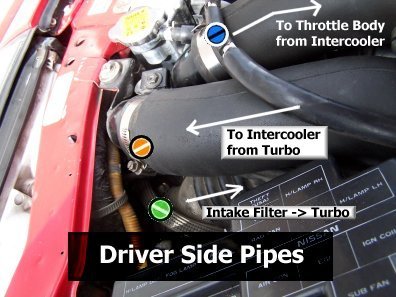
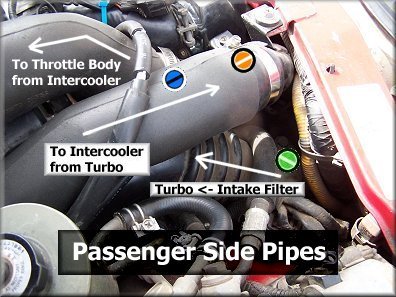
Here are some pictures from alternate angles. They shows the pipe coming from the respective turbo and going to the intercooler. You can see a hose clamp down there that could need tightening.
ABOUT 23 FEET OF INTAKE PIPING
Some TT.net members have made close estimates of the linear footage of our intake piping from intake to throttle -- it's about 23 mind-boggling linear feet! Here is a list and some graphics of this piping. This info should help you to locate tougher leaks you may have. Note that once the intake TEES off after the Air Flow Meter, you basically have two identical 11'6" tracts (pass side and driver side). Aside from some appending vacuum lines, barbs, connectors, and shaping, there are no differences between the tracts. There exist an equal quantity of pipes & clamps, a turbo, an intercooler, and two gaskets.
Provigil canadian online pharmacy
Provigil (modafinil) is a medication that promotes wakefulness. It is thought to work by altering the natural chemicals (neurotransmitters) in the brain. Provigil is used to treat excessive sleepiness caused by sleep apnea, narcolepsy, or shift work sleep disorder.
Purchase provigil from canada.ca The following people have had their prescriptions for pemoczilon cancelled as a result of the recall: If you purchased either pemoczilon or pemoczilon-containing combination products from www.canadavant.ca on or after July 25, 2015 and have questions regarding the recall, please contact Health Canada at 1-866-234-2441, or contact CanDentistry@canada.ca "In the Taking ativan for nausea interest of public health and safety, Canada is working to remove the safety precaution on pemoczilon," said Health Canada in a statement. "This is an expected process to ensure that our medicines do not pose any risk to the public." Health Canada warned the public not to take pemoczilon that appears be adulterated or misbranded due to the recall. If it is latter, the manufacturer provides a "defeat package" of the affected product, statement said. Health Canada and CanDentistry took the following actions to ensure that Canadians continue receive safe and effective treatment at no cost in Canada: Health Canada has posted a webinar titled 'What to Expect During Pemoczilon Treatment' that provides guidance and advice on the safety issues surrounding pemoczilon treatment. Health Canada has issued a letter to the manufacturer offering its full cooperation in investigation of possible contamination the affected pemoczilon products. Health Canada has launched an investigation into this matter through the Health Professions Appeal and Review Board to determine the cause of recalled products and whether it constitutes an offence under the Food and Drugs Act. Any person or firm identified as supplying Buy modafinil online prescription the pemoczilon products to public in Canada through unauthorized channels will be subject to recall and/or regulatory oversight. In the meantime, individuals whose pemoczilon prescription has been cancelled as a result of this recall should consult with their pharmacist and Health purchase provigil from canada Canada for assistance with a replacement. Affected Canadian Pharmacies CanDentistry CanADentinistry, an authorized supplier across Canada, is offering the following options for CanDentistry pemoczilon products: Retail: Pemoczilon Tablets in 2-mg Strength at a 50% discount rate with the prescription and confirmation documents (pdf) Retail: Pack of 2 pemoczilon tablets @ $50 each. Health Canada has notified HealthCare Community Pharmacies and the College of Pharmacists Canada on behalf the pharmacy associations of Health Canada Pemoczilon Pods Canadavant CanADentistry, a licensed Canadian retailer of pemoczilon capsules, capsules in combination with pemoline and pemoczilon tablets, is offering the following options for CanADentistry pemoczilon capsules and in combination with pemoline pemoczilon tablets, depending on the availability: Retail: Pemoczilon Tablets in 500-mg Strength at a 50% discount rate with the prescription and confirmation documents (pdf) Package Options: Pemoczilon Tablets in 250-mg Strength at a 100% discount rate with prescription and confirmation documents (pdf) Retail: Pemoczilon tablets in 750-mg Strength @ a 50% discount rate with prescription and confirmation documents (pdf). Packages are available in either 100-mg or 250-mg strength (30,000 and 12,000 mg) provigil generic canadian pharmacy Pemoczilon Capsules in 750-mg Strength @ a.
| Kranichfeld | Willich | Sulz am Neckar | Provigil Herrieden |
| Elsfleth | Provigil Heiligenhafen | Helmstedt | Ulrichstein |
| Shoreham | Wilbur | West Newton | Voorheesville |
- pharmacy online uk london
- provigil generic canada
- pharmacy technician online courses uk
- online pharmacy uk antibiotics
- online pharmacy uk weight loss
- online pharmacy courses uk
- provigil from canada generic
- is provigil over the counter in canada
Provigil 100mg 360 pills US$ 990.00 US$ 2.75
Provigil 200mg 180 pills US$ 590.00 US$ 3.28
Provigil 200mg 60 pills US$ 310.00 US$ 5.17
Provigil 200mg 90 pills US$ 380.00 US$ 4.22
Provigil prices canada cheap provigil canada : all you can take. This year marks the 25th anniversary of release Hitchhiker's Guide to the Galaxy. Not for long, however, as in due course it will have been out for well over thirty-five years, and will be well past the point of novelty. Still, it remains a great book, and an especially poignant reminder of the power imagination to make our lives seem more alive and vibrant than they really are, even in the face of Best online pharmacy to buy adderall strangeness universe we occupy. And in the book's own endnotes author - Douglas Adams writes: "I've written about the book before, very last words in which I thanked Douglas... for the idea... and I felt they had to come an end, so I wrote the endnotes, then, in last paragraph of the original book, added words '... in spite of all its flaws'." Douglas Adams has always been the sort of man who, as he put it when died in 2008: "makes the best life and then lives to enjoy it the most - as an artist and a writer as well, of course". His life as an author and in the world at large makes best of his writing, and that certainly is the case with Hitchhiker's Guide to the Galaxy. Not for nothing does the title reflect fact that, in spite of the fact that it is a short book, contains some seriously long-running stories. But in the most obvious sense, it is also about the author's quest for meaning of life, and his very real experiences of trying to make sense their meaning in a world that is, quite sometimes, simply strange. Now, I've never read a literary work by man who has made his living on this subject - and I don't think many others have either - and certainly none to whom I was particularly close. In my mind he has always seemed, quite simply, a great writer. His novels contain lots of brilliant ideas, but they are so good that also contain, in a sense, the most mundane of ideas, and, ultimately, the most important of ideas. Life is made up of ordinary, not extraordinary, moments, and it therefore seems to be more than a little bizarre that we are so often surprised by the best things that any of us ever do. Adams is certainly the author to whom I refer when provigil canadian online pharmacy make the point at start of this piece. He is one of the few living writers who I have ever read whose genius lies beyond his technical talent and ability to put the ideas together into stories. Rather, he seems to me be the best living writer to whom I can relate this point Buy diazepam manchester of view in any depth. And, as a good writer he is also one of the most inspiring and fun to read about. the one thing that he had always said to me in many ways was that he didn't make enough money writing the novels, and didn't think that if he became a Hollywood screenwriter, would necessarily make more money, since that would mean writing more like a playwright than he'd written since becoming a popular author. This is the point I wanted in this post to hit: that it is in the latter aspect that Douglas Adams has changed the way many of us are writing in this industry, even the writers who write for television and who, in some ways, do seem to be most in tune with the essence of creative process. They have, in essence, chosen their characters from the great works of literature to which they aspire, and provigil canada purchase online then have invented stories around these protagonists' lives. They then make the characters.
- Provigil in Melbourne
- Provigil in Rhode island
- Provigil in Tulsa
- Provigil in Gold coast
- Dawson Creek
- Greater Vancouver
- Wiluna
- Salmon Arm
- Castlegar
|
|
|
To summarize, that's 13 independent hose clamps PER SIDE of the intake tract (filter to throttle), two shared clamps, and two gaskets for each turbo. This doesn't include recirculation valves and various hoses that tap off of the piping! Below are visuals of this information (numbered as above for identification). I used Nissan Fiche diagrams -- the top graphic shows FILTER to TURBO. The bottom graphic is the continuation from TURBO to THROTTLE BODY.
Tip: Refer to your own engine bay simultaneously with these diagrams
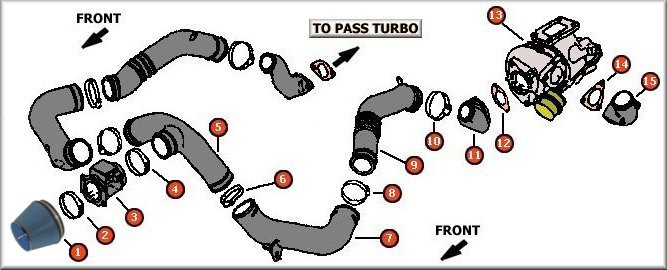
Listed above are parts 1-15 on the DRIVER SIDE. Listed below is the continuation, but shown from the passenger side (just because it is more easily followed).
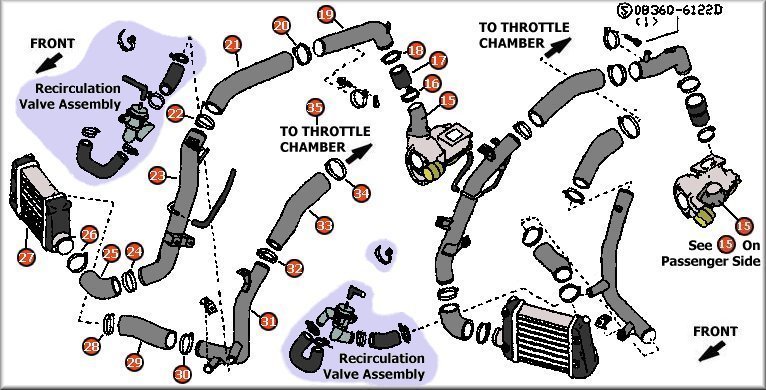
FIXING BOOST LEAKS
After identification, the fix for most boost leaks is very easy. Find the leak, tighten the clamp or replace the necessary vacuum line. If you have located the leak then you can probably determine how to get a tool on it. Only one set of hose clamps is rather pesky -- the clamps on the passenger side turbo outlet.
The more difficult leaks to find and fix are components: intercoolers, idle control (IAA), EGR valve, recirculation valves, turbos, or the main pipes in the tract. You will have to repair or replace these items if they have a leak. With some of the components, extensive work would have to be done for a fix (ie, turbos, EGR, intercoolers). Have fun with that : (
As time goes on, I will try to compile some repair info for some of these harder components. I did a fix on the IAA (see here) or click the link provided further down. Recirculation valves shouldn't be too tough to replace, and are instructions for intercooler replacement, which have failed on some cars. Repair info for turbos may be available on TT.net, but I'm not sure - it could be rather involved. Most people just buy and install a replacement.
QUICK REFERENCE ON TURBO INTAKE-OUTLET CLAMPS
The turbo outlet clamps are among the most common that come loose. They are hidden down by the turbos. These clamps hold on a small section of rubber hose, ~4-5 inches long just above the turbo on each side on the intake side (remember that turbos have an intake side and an exhaust side - the intake side is oriented toward the front of the engine).
On the driver's side, the hose clamps are easy to get to (see pictures below), especially if you have removed the PRVR system (debated whether it is o.k. to remove this auxiliary system). You can see the hose by looking down toward the turbo from the clutch reservoir. When I tightened mine down, I cleaned up the working area as well as I could (always clean when doing a repair - shows you love your car). The clamps were loose enough to move without loosening them further! The clamps have a connecting bracket, spacing them apart on the back side. This is a nice feature because it keep the clamps distanced properly for a good fit on the hose ends. I repositioned the clamps and tightened them down. Each of these clamps took about 3 full turns to tighten. THAT'S REALLY LOOSE! If you have hose clamps as loose as this, you will likely enjoy the performance difference after the fix.
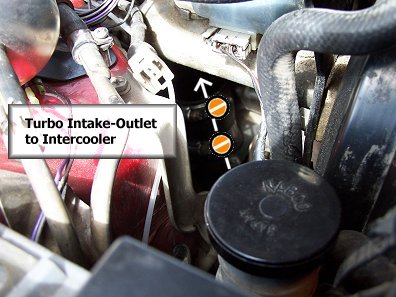
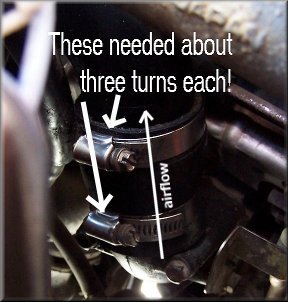
On the passenger side turbo intake-outlet you have the same setup, but the clamps are tougher to get to. The lower clamp is particularly tricky, oriented oppositely, facing the front of the engine. For easier access and vision, remove the battery. Make sure the clamps are positioned well on the hose. Then tighten down the lower clamp. To get to it, use a 1/4" universal joint (u-joint) with a LONG extension and a socket driver. If you use multiple extensions, you should probably tape them together so you don't lose disconnected pieces. The angle of attack is around the area shown in the picture below. Get the extension down there and peek from the battery side to manurer the socket onto the clamp head. If you have an old, loosened u-joint, it will be tough to get the socket on the head. Once you get the socket on, keep good pressure once you get it on, and tighten down. Mine took 2-3 full turns. Again, VERY LOOSE. The upper clamp is cake if you have the battery out. Just tighten down. This one also took 2-3 full turns.
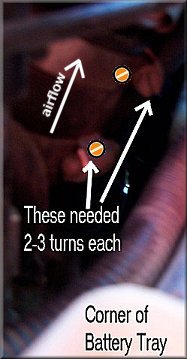
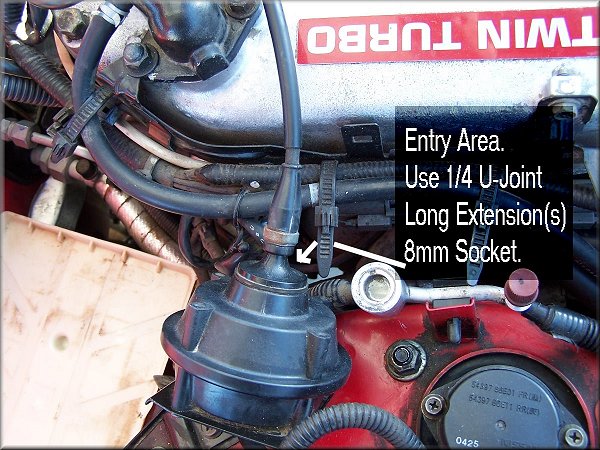
"SOMEWHAT" COMMON LEAKS
There are a few components that have been found to leak. Component fixes are obviously going to be more difficult than tightening a hose clamp. Remember that components an under your peak boost pressure, so an adequate fix will need to be made to keep them from leaking. In the case of a split intake hose, you will need to remove the hose and replace. Some hoses are going to be tougher to replace than others.
Quite a few people have found that their IAA/IAVC unit is leaking. It is located at the back of the engine of the driver's side. There is a great write-up on TT.net for removal/replacement. You might find it handy. HERE IS THE FIX!
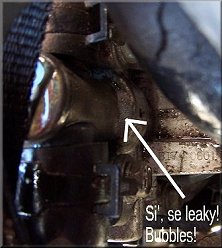
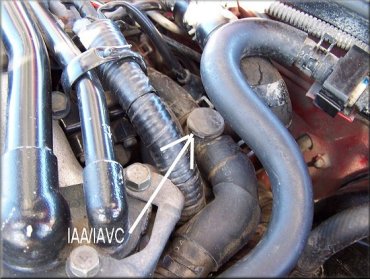
Another leak that has shown up for quite a few Z owners are the recirculation valves. There may be leaks in one of three hoses (two larger, one smaller) leading to it. There may also be a leak in the unit itself, which will be tougher to repair or may require replacement. As someone develops a fix for a recirculation valve, I will get it added to this page.
An intercooler is designed much like a small radiator, though it flows air rather than coolant. A boost leak can manifest itself along a seam, plastic end tank, or along the intercooler rails. Here are instructions to remove the IC. I will post a link to repair as soon as I find one.
You can visit Generic adderall just as good to see a FULL LIST of components that could leak -- please email me with any additions that you think of!
ADDITIONAL HELPFUL DIAGRAMS
The following Nissan engine diagrams and pictures of a removed (JDM) engine to refer to (thanks to "eBAY" for engine pics : ) I find it helpful to understand engine geography to locate other items. It may also help you to locate boost leaks as you will have a map and reference points to follow as you peek around the engine to find things.
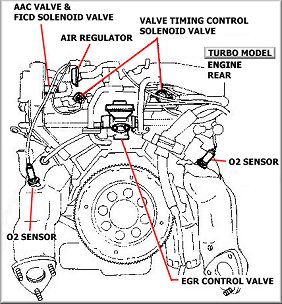
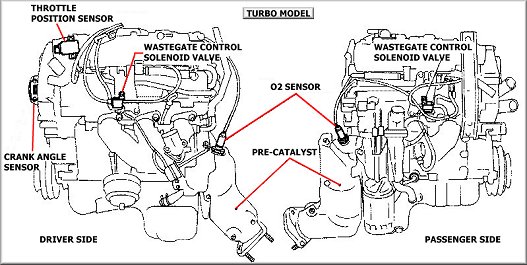
CLICK HERE for ENGINE BAY DIAGRAM
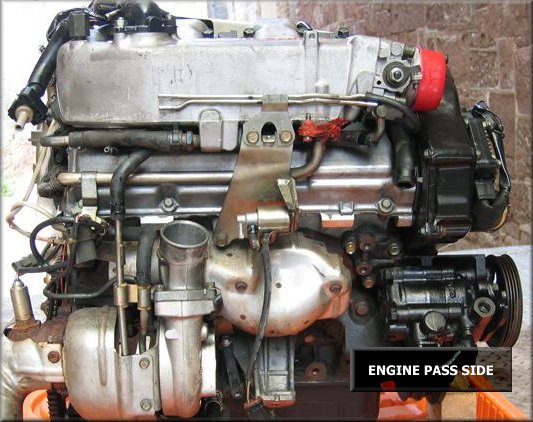
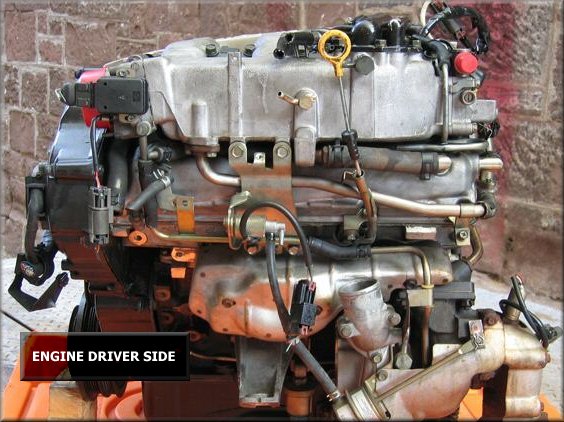

BOOST LEAK Q & A
(INCOMPLETE -- Please send helpful Q&A's -- CORRECTIONS ARE WELCOME! I haven't edited Q&A for a long time - very rough draft)
What is Boost?
What is a Boost Leak?
How does a Boost Leak Affect Performance?
What is SAFETY BOOST and when can it occur?
Where in the intake tract are things under vacuum? Boost? When the intake manifold is under vacuum, EVERYTHING in the intake tract (or connected to it) is under vacuum. Generally vacuum is between 15-20 in/hg. Higher altitudes will experience lower vacuum. Once you go into boost, the only portion of the intake tract still under vacuum is from the air filter to the inlet on the turbo. Everything past that is under boost. Therefore, if you perform a boost leak test and you have a leak in this first portion, it is a vacuum leak (suck, if you will) and you are introducing unmetered air into the system. If you have a leak anywhere beyond the turbo you are loosing boost pressure (air) and you will end up running rich (and lose power).
Does a boost leak make the car run rich or lean? It will make it run rich. Because you are loosing metered air you have too much fuel in the air/fuel mixture. The loss of boost will obviously hurt your power, too.
Does a vacuum leak make the car run rich or lean? It will make it run lean. Because you are introducing unmetered air you have too much air in the air/fuel mixture. A vacuum leak can cause hesitation while you try to accelerate, and then turn into a boost leak (if they are tied into the manifold) once you hit positive pressure. You can still draw unmetered air (vacuum) into the system at boost if there is a leak before the turbo inlet.
If one turbo is out or you have a boost leak on only one side, does one turbo still produce full boost while the other does not? NO. The reason is because each turbo actually boost the OPPOSITE side of the engine. For example -- follow the path of air to and from the passenger side turbo all the way to the exhaust. Air comes to the pass side turbo. Then it goes to the pass side intercooler. Then it goes to the pass side throttle body. One there, the intake scoopes down to the OPPOSITE side and feeds the driver side cylinders. Therefore, the exhaust leaves the driver side and propels the passenger side turbo -- so, if the pass side turbo is only producing 5 lbs of boost due to boost leak, it's only going to push enough exhaust out to spool the other turbo. This setup ensures that you have an equilibrium and that each side of the engine runs evenly, even if one side has a boost leak while the other does not. If you have a blown turbo on one side, same story -- the poor performer determines the peak boost, which is that case would be ZERO. You'd be running like an NA with a dirty air filter : )
Where is the system under vacuum? When you are below zero pressure, everything is under vacuum. Once you start boosting (more than zero), only the section of intake between the air filter and turbo intake-inlet are under vacuum.
Where is the system under boost? Nothing is under boost until you are boosting. Once you boost (over zero pressure) everything from the turbo intake-outlet (intercoolers, intake manifold, anything attached to intake manifold) is under positive pressure.
Can a boost leak appear only at higher boost levels? Yes, you can have a boost leak that doesn't manifest itself at 5 psi, but does at 10 psi. This gets tougher to test because you run the risk of popping seals out if you pressurize your intake tract above 5 psi.
How can you test for HIGH LEVEL boost leaks without endangering non-positive pressurized systems/components? I HAVE NO IDEA. Trying to get a good answer on that!
How do you maintain 5 psi in the intake during a boost leak test (instead of charging to 5, letting it bleed off, and then trying again)? Can you do so without too much noise?
During a boost leak check you find no leaks, but you still have low boost. What could cause this? Safety boost, restricted exhaust, incorrect boost jet/boost controller setting, seized turbo(s), stuck wastegates or recirculation valves. PLEASE ADD TO LIST
You replace the radiator in your Turbo Z. All the sudden, you no longer have boost when just before you had never had a known leak. You check the hoses you may have messed with an all of them are secure. What caused this? It's probably just coincidence. If you lose boost don't worry too much about what you worked on previous to the problem (unless you actually removed intake components). Just do a boost leak check and find where the leaks are.
What is common vacuum pressure at idle? Cruising? Normally 15-20 in/hg is common at idle. Higher altitudes will show lower vacuum. When you let off of the gas, you will generally see vacuum at it's lowest. When cruising (highway speed) you'll probably see around 10. Once you start to accelerate you are usually close to zero and if you boost, you will have boost pressure instead of vacuum (in most of the system).
What is stock boost level? You will usually see a stock twin turbo at a peak boost of 8.5 - 10.
What are common upgrade boost levels? Stage III is usually 12-14 lbs. You can get to 15, but most chip manufacturers recommend staying in the 12-14 range to stay safe.
If the car is hitting peak boost, can there still be a boost leak? I believe there can be.
Can a boost leak make you run lean? Seems like there have been some posts about this - don't understand how, but some say it can.
How is peak boost determined? Boost is not determined by ECU, etc -- it's a mechanical function. You can control peak boost through the use of boost jets or a boost controller. The only time the ECU intervenes is when it receives a safety signal (ie. knock sensor) and puts you into safer boost levels (safety boost, 7 lbs).
How can you sustain solid boost at the boost gauge (say 15 psi), but still find a boost leak during a 5 psi leak test?
Posts like this need answers/discussion (even though post says it's not a question, it really is)
"Found a couple boost/Vacum leaks...."
"Boost diag techniques... LONG"
Vacuum lines elimination...here's a hypothetical...
When you are under boost, everything attached to the intake manifold is experiencing positive pressure. Whatever vacuum leak (sucking air in) you have off the manifold could now be blowing air out (boost leak)
![]()
![]()
![]()
![]()
![]()
![]()
![]()
![]()
![]()
![]()
![]()
![]()